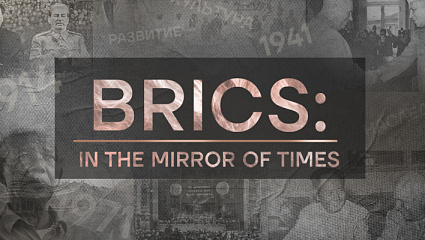The "Star House" Turned 90
Artem Evdokimov, correspondent: "The history of the Moscow Planetarium began with this device. 90 years ago, with its help they "lit" the starry sky here for the first time. By the way, the device itself is called "planetarium". At that time, they regarded it as a modern space innovation!"
The star house in Moscow was opened at the end of 1929. Then only three European capitals – Berlin, Vienna and Rome could boast of planetaria. There was hardly more than ten of them all over the world. No wonder people stood in queues to see the first space shows.
Faina Rublyova, Scientific Director of the Moscow Planetarium: "It was an astonishing event for Moscow in the end of the 1920s. It was 1929. Civil War had just ended. 10 years after the Revolution, a little more. And of course, the country was in terrible ruin. We reminisce this time by historical documents. And nevertheless, in Moscow, which still had 5 thousand horse cabs riding about, they decided to construct such a technological construction, in modern language."
Among the first visitors, there were many celebrities. Myriads of fires on its dome enraptured Vladimir Mayakovsky, he even wrote a poem about it. However, Konstantin Paustovsky who came with Mayakovsky found defects. Artificial stars did not impress the writer who had a sophisticated sense of nature.
Faina Rublyova, Scientific Director of the Moscow Planetarium: "He (Paustovsky) was surprised that stars did not flicker. He was a very attentive person. Not everyone will understand at once in what way the artificial sky differs from the real one. And here he told – you have a lifeless sky, stars do not flicker. And Mayakovsky who brought him here, of course, his role is big in this case. If it was not for him, maybe, the fates of planetaria would be different. Because they said at the Zeiss plant that it could not be done."
The staff of the Moscow planetarium were the first to figure out how to "liven up" the sky. They found a simple solution. They put a special grid above the device. It rotated and blocked star beams for a fraction of a second. As a result, they succeeded to achieve a flicker effect. This story is told in the museum today. By the way, it was not here before. It appeared after reconstruction when the building of Planetarium was raised by 6 meters. Here, many unusual exhibits are displayed. But perhaps the most interesting ones are those which arrived from space.
Alexander Molostvov, Research Associate of the Moscow Planetarium: "This is a real meteorite, it is not fake. Actually, these are 3 different meteorites which can be found in 3 different places of our country. And fallen to our planet at different times."
The weight of the largest stone is one and a half tons. It is heavier than all splinters of the Chelyabinsk meteorite. And yes, it is also no more than a splinter of a celestial body which fell to the ground thousands of years ago.
Alexander Molostvov, Research Associate of the Moscow Planetarium: "If it fell today, it could throw our civilization back. Such a strong falling has not occurred recently. Quite possible, there would be a very strong electromagnetic impulse. It could bring electronics out of operation. It could cause a banal crop failure. I mean, it had enough force to cause the so called "year without summer". Respectively, less food, hunger. Of course, the mankind would not disappear, but it can lead to some extra challenges.
Our globe the most beautiful one, it the brightest, multi-colored. This is the sign of presence of life on it! All the rest are lifeless…"
And this is the hall with huge globes of planets of the Solar system. The terrestrial one is really special, and not only because it is the most colourful one. This exhibit is almost of the same age as the Planetarium. The globe was one of the two made by request of Stalin himself. It was displayed in Beria's office for a long time.
Faina Rublyova, Scientific Director of the Moscow Planetarium: "When in 1953 Beria was arrested, various objects were taken from his mansion located near Planetarium, across the road from us. And this globe was simply brought across the road, to our Moscow Planetarium. And since then, it has been one of our exhibits. (About experiments on electricity) The better part of this current goes to the earth through your legs. But the smaller part goes through a bulb, through me and further to the earth."
One more highlight of the Moscow Planetarium is Lunarium. This is an interactive space where children get to know about space, fundamentals of astronomy and physics while playing. Here they will teach you to "operate" lightnings, help to know your weight on different planets and will even allow you to jump upon a lunar surface.
Maria Dudykina, visitor: "I want to know if aliens exist."
Alexander Molostvov, Research Associate of the Moscow Planetarium: "We can create, for example, our own little lightning or look how electric current is transmitted at a distance. We can look at the movement of planets around the Sun. Children can catch asteroids and protect our earth, throwing them at other planets."
Today, Russian astronauts visit the Planetarium very often. It is a tradition. In the middle of the twentieth century, the building with a high dome became a symbol of progress and new era. Here, lectures on astronavigation were attended by the first spacemen.
Faina Rublyova, Scientific Director of the Moscow Planetarium: "And nobody knew who these people were. They thought those were pilots of polar aircraft who also needed to study the starry sky. But when Gagarin flew into space, when they saw all his photos, it became clear that he used to come here, and his friends – also the future astronauts. And of course, the role of the Planetarium in it is huge! The first liquid-fuel rockets were designed and assembled here!"
The Planetarium is annually visited by more than one million people. Just like 90 years ago, they are still enchanted by majestic and far objects of our Universe. Zeiss’s projector still makes stars a little closer to us. Only now it is the latest model. The device draws on a dome fantastically beautiful pictures of 9 thousand celestial bodies.
After reconstruction, the Star House in Moscow was included into the Top Five planetaria of the world according to its technological infrastructure.
Artem Evdokimov, Vladimir Bragin. TV BRICS.







 DIGITAL WORLD
DIGITAL WORLD




































